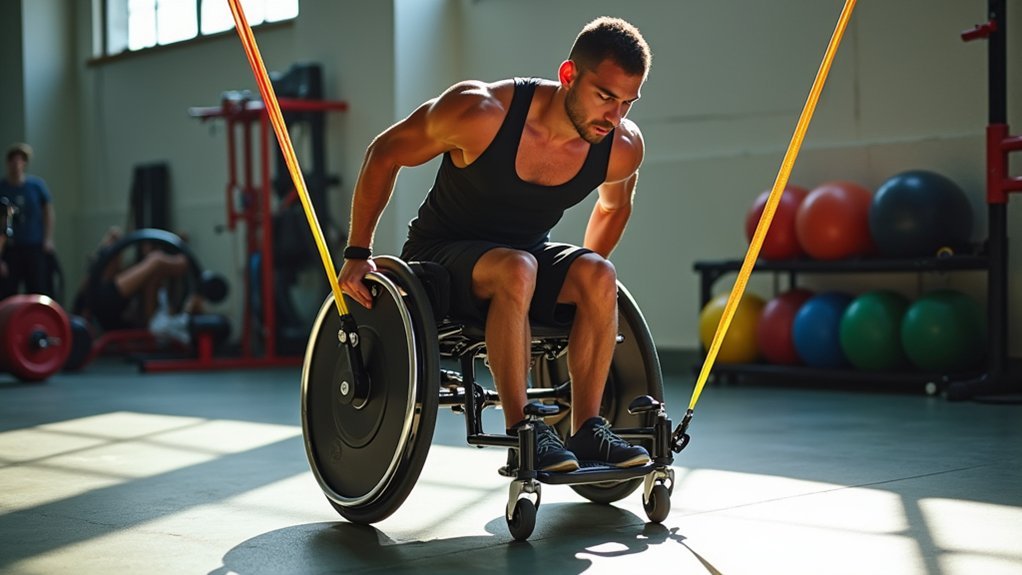To build maximum power from your wheelchair, focus on compound movements like seated rows, resistance band bench presses, and wheelchair dips that engage multiple muscle groups simultaneously. Add progressive overload by increasing resistance band tension every 2-3 weeks. Strengthen your core with seated twists and Pallof presses for better stability. Don’t overlook recovery—proper protein intake, hydration, and sleep are essential. The right combination of these elements will transform your strength training routine.
Upper Body Compound Movements for Maximum Strength

Five essential compound movements form the foundation of wheelchair strength training. Seated rows and resistance band bench presses simultaneously engage multiple muscle groups, maximizing strength gains while improving posture.
For powerful shoulders and triceps, incorporate overhead presses and modified push-ups into your routine.
Don’t overlook functional fitness movements like wheelchair dips and tricep extensions that directly enhance daily activities and boost pushing strength for better mobility. When performing these exercises, engage your core for added stability and strength development.
Prioritize functional movements to build real-world strength while maintaining proper core engagement for maximum training benefits.
Using resistance bands with adjustable resistance allows you to progressively challenge your muscles as you grow stronger.
Aim to include these upper body strength training exercises 2-3 times weekly for best results, enhancing both power and functional independence in your wheelchair exercises regimen.
Resistance Band Techniques for Progressive Overload
Building upon the compound movements we’ve covered, resistance bands offer exceptional versatility for wheelchair users seeking continuous strength improvements.
They’re ideal for progressive overload, allowing you to gradually increase resistance as your fitness level advances.
To maximize your strength training, increase repetitions, sets, or band tension every 2-3 weeks.
Anchor bands at different heights to target various muscle groups, creating a truly customizable exercise program.
Don’t forget to incorporate variety by adding movements like ab crunches and oblique swings to develop overall strength.
Safety remains paramount—regularly inspect your resistance bands for fraying or wear and replace them when needed.
This consistent approach to progressive overload guarantees continuous adaptation of your muscles, leading to significant power gains without compromising your wheelchair mobility.
Core-Strengthening Exercises for Wheelchair Stability

A strong core serves as the foundation for wheelchair mobility and independence, acting as your body’s natural support system during everyday movements. For wheelchair users, developing core strength is essential for maintaining proper posture and enhancing stability while maneuvering daily tasks.
Try incorporating seated twists and the “Zombie Twist” to improve your balance and ability to navigate around obstacles. Resistance band abdominal crunches and Pallof presses target your core muscles effectively, reducing injury risks associated with extended wheelchair use.
Core strength isn’t just about muscle—it’s the key to smoother wheelchair navigation and reduced injury risk.
These exercises strengthen both abdominal and back muscles, which helps you maintain an upright position and push your chair more efficiently.
Consistent core workouts will improve your performance in other physical activities too, boosting your confidence and independence while decreasing discomfort from prolonged sitting.
Adaptive Equipment to Amplify Power Development
While a strong core creates your foundation for wheelchair mobility, the right adaptive equipment transforms your strength training potential. Resistance bands offer adjustable tension for progressive muscle challenges, while hand cycles build upper body strength and cardiovascular endurance by engaging your arms, shoulders, and core.
| Equipment | Power Benefit | Training Impact |
|---|---|---|
| Resistance Bands | Adjustable tension | Progressive muscle growth |
| Hand Cycles | Arm/shoulder engagement | Improved cardio endurance |
| Weighted Vests | Added resistance | Increased force production |
| Medicine Balls | Explosive movement | Multi-muscle activation |
| Adaptive Machines | Tailored resistance | Safe, stable support |
Weighted vests intensify bodyweight exercises, requiring more force generation. Medicine balls enable explosive power training through exercises like criss-crosses. For maximum results, incorporate these adaptive fitness tools into your wheelchair exercises, building functional strength that translates directly to improved daily mobility.
Recovery Strategies for Optimal Strength Gains

Because your muscles rebuild during rest periods rather than workouts themselves, strategic recovery becomes just as important as your actual strength training.
Rest isn’t just downtime—it’s when your body transforms effort into strength.
Incorporate active recovery days with wheelchair yoga or light stretching to enhance flexibility and prevent soreness.
Consume 20-30 grams of protein within 30 minutes post-exercise to support muscle repair.
Don’t underestimate hydration’s role in maintaining muscle function and reducing fatigue.
Prioritize 7-9 hours of quality sleep nightly, as research confirms it considerably boosts strength performance.
Try foam rolling or massage techniques to alleviate muscle tension and improve blood flow.
When you combine these recovery strategies—proper hydration, timely protein intake, active recovery, sufficient sleep, and myofascial release—you’ll create the ideal environment for strength gains and better overall health.
Frequently Asked Questions
How Do You Build Muscle in a Wheelchair?
You’ll build muscle by performing upper body resistance exercises like lat pulldowns and seated rows. Use resistance bands for versatility, train consistently 2-3 times weekly, and combine with hand cycling for overall strength development.
What Is the Best Exercise for Someone in a Wheelchair?
You’ll benefit most from resistance band exercises that target multiple muscle groups. Focus on chest presses, lat pull-downs, and core strengthening movements to build functional strength that improves your daily mobility and independence.
How to Build Stamina in a Wheelchair?
To build stamina in a wheelchair, try hand cycling for 15-30 minutes 3-5 times weekly. Add interval training by alternating intensity levels. Don’t forget resistance exercises for upper body and stay well-hydrated throughout your workouts.
How to Build Upper Body Strength in a Wheelchair?
To build upper body strength in a wheelchair, focus on resistance band exercises like Pallof presses, incorporate seated shoulder rotations, and practice push-ups adapted to your ability. Aim for 2-3 weekly sessions with increasing resistance.
In Summary
You’ll build maximum power through consistent practice of compound movements, progressive resistance training, and dedicated core work. Don’t underestimate adaptive equipment’s role in reaching your strength potential. Remember to prioritize recovery between sessions—it’s when your muscles actually grow stronger. By combining these wheelchair strength approaches, you’ll develop functional power that translates to improved mobility and independence in daily life.





Leave a Reply